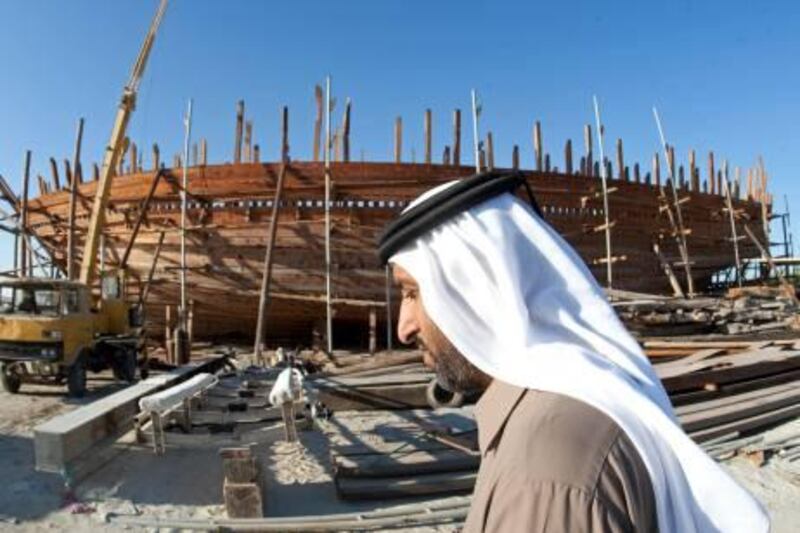DUBAI // Two Emirati brothers have made it their mission to honour their ancestors' craft of building traditional wooden boats with a majestic addition to the emirate's coastline.
Glimpses of the huge craft can be seen behind a cluster of trees in the Al Jadaf drydocks area. It is only when the visitor approaches the worksite and sees the large wooden ship surrounded by massive timber beams that the scale of the project can be fully appreciated. If this were a building, it would be the Burj Khalifa.
"We are building this boat to ensure that traditional boat-building does not become extinct," said Salah Ahmad al Merri, a retired naval officer and the older of the brothers, at 45. "We decided with our limited means to preserve this tradition by building a boat that can carry 2,000 tonnes of cargo."
Salah and Huraiz, 37, have a connection to the sea that is evident in their family's lineage, and their dedication to the country's heritage. They started building boats together more than a decade ago.
"From both our maternal and paternal side, our grandfathers were seamen," Huraiz said. "One of them built boats and the other was a seafarer who was the leader of about 100 ships."
Their father, who passed away last year, would consider his sons' project to be folly as they are financing the whole initiative, Huraiz said. It could cost as much as Dh7 million to build the leviathan. Huraiz has adopted a hands-on approach to working on the ship and even has a heavy machinery licence that allows him to drive a crane, so he can increase his involvement.
"You have to throw [personal] caution to the wind when building a boat like this," he explained. "Seamen are prepared to fight with the sea and make peace with it, so you cannot be afraid of a piece of wood falling on your head."
Feeling the boat was worthy of a grand name, Huraiz said he asked for permission to call the dhow Fazza, the pen name of Sheikh Hamdan bin Mohammed, the Crown Prince of Dubai and a published poet. "He gave the go-ahead to name the boat after him and it is our responsibility to produce the finest boat," Huraiz said.
From a distance, the vessel's sleek contours are a testament to hours of hard work by the brothers and a gang of 10 workers. The amount of human effort becomes evident when approaching the ship and realising that practically every square foot is skewered in place with three or four massive nails.
"This is going to be the biggest traditional wooden dhow in the Arabian Gulf," Huraiz said. "We started building this boat at the start of 2008 and we plan for it to be ready this time next year.
"My grandfather would use his hands to secure the nails in place and his arms would hurt after he made holes for 15 of them. Today we use the drill. I have an eight-year-old son who works on the boat with me sometimes.
"Dubai Creek was the heart and pulse of Dubai, so we are ready to train the younger generations."
Salah has a pragmatic approach to the changes in technology that have taken place in the past few decades and wants to ensure that younger generations can continue to practise traditional craftsmanship.
"What I would like to see is a specialised area in Dubai for people to build traditional boats on the coast, and for us to train young Emiratis on how to design, build and administer such boats," he said.
A veteran of the sea, he takes a sheet of paper and sketches the design of the boat expertly, explaining how the pieces fit. He said his interest in designing boats stretched back to when he was seven. "I used to take a large olive tin and design a boat. I would get my mother to hold it as I put up the mast."
The brothers said that tourists who went on helicopter rides often saw the boat from above and found their way to the worksite to take pictures. They hope the vessel will embody the rich tradition of Emiratis who took to the water before them.
"The people of the Emirates have sailed to the far corners of the world and used to depend on the sea," Salah said. "We did not just have one Ahmad bin Majid [a famous Arab navigator and seaman], but hundreds of others like him."






